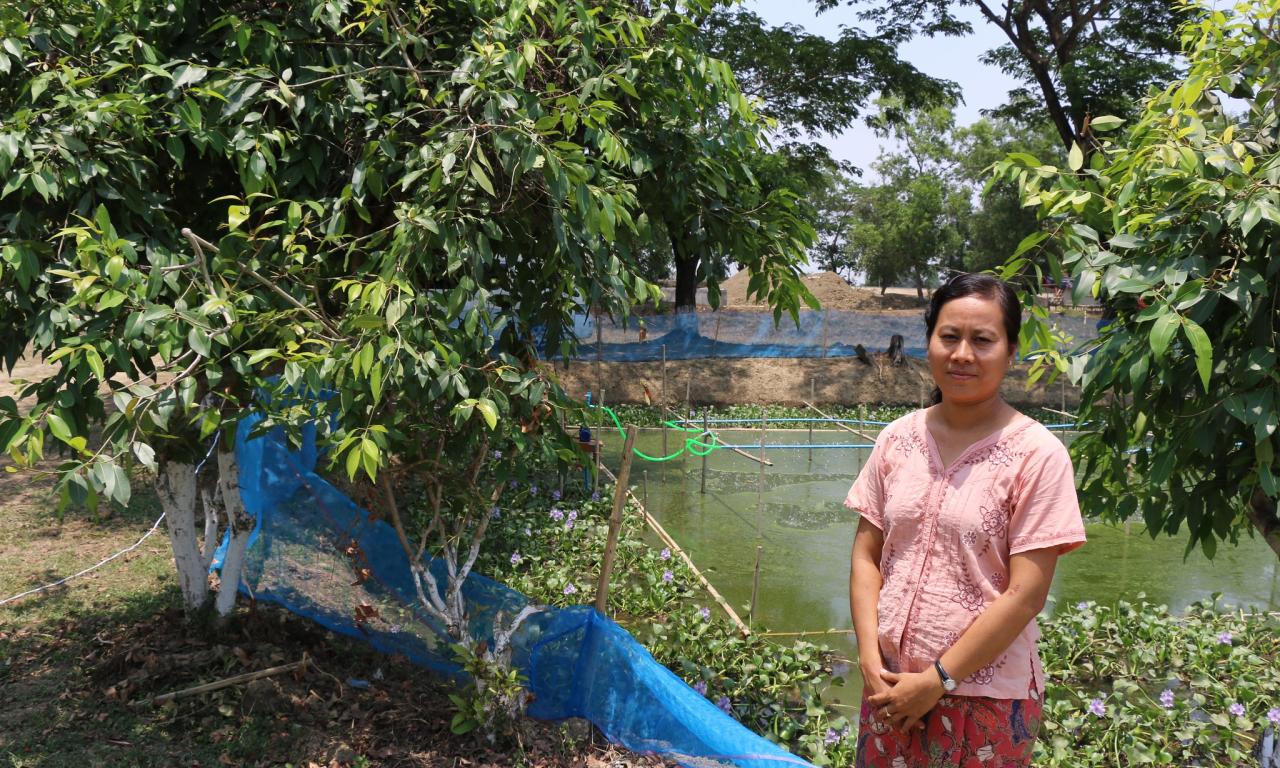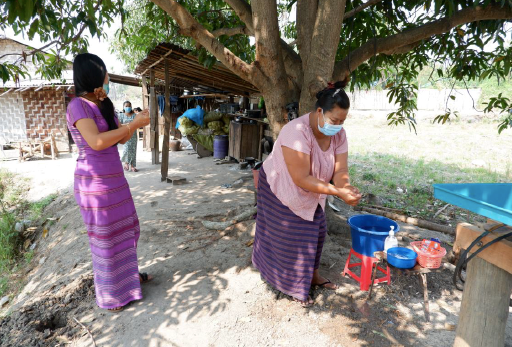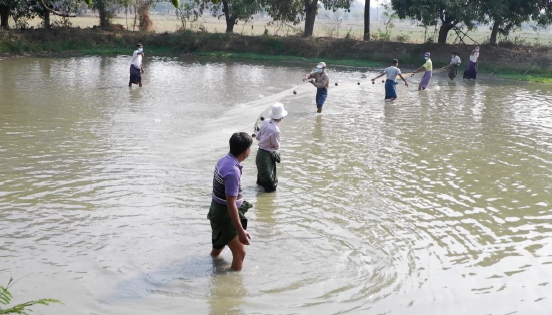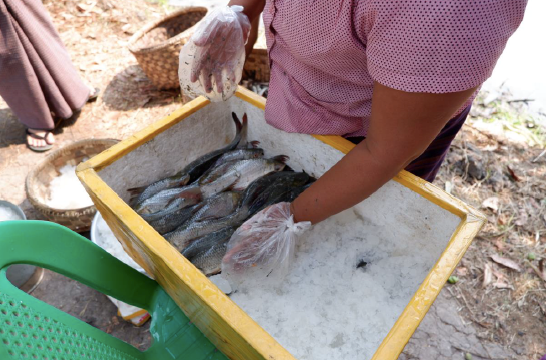
In the Central Dry Zone and upper regions of Myanmar, since April 2017, the Inland component staff of the Myanmar Sustainable Aquaculture Programme (MYSAP) has been working intensively with smallholder fish processors and vendors to improve fish value chains. To boost the opportunities of female micro-entrepreneurs in Kale, Shwebo and Kengtung townships, in March 2020, MYSAP Inland selected as a partner of choice the BoP Innovation Center (BoPInc). BoPInc has extensive experience in supporting women entrepreneurs as well as in the development of business models benefitting the Base of the Pyramid (BoP), low-income consumers, and entrepreneurs. Through their expertise, BoPInc will assist in the co-development of post-harvest fish value chain innovations with female micro-entrepreneurs working on fish processing and vending, empowering these women to solve problems they face every day. However, due to COVID-19 lockdown restrictions, working closely with female micro-entrepreneurs and surveying their business in the marketplace was temporarily halted.

Survey conducted via mobile phones
MYSAP Inland and BoPInc kick-started their collaboration with the development of a short computer-assisted telephone interview (CATI) questionnaire survey to gather data from fish value chain actors in Myanmar. The survey collected information on the level of mobile phone accessibility, digital abilities, and the overall COVID-19 understanding of fish value chain actors targeted by MYSAP Inland with innovative fish post-harvest training, and messaging. As a result, a total of 41 respondents (32 women), including village and main market fish vendors, wholesalers, and fish processors, previously trained by MYSAP on value-added fish products were interviewed by mobile phones. These included key value chain stakeholders from all the MYSAP Inland targeted regions of Kale (5 people) and Shwebo (14 people) townships, in the Sagaing Region, and Pinlaung (11 participants), and Kengtung townships (11 participants), in the Shan State.
The findings revealed that phone usage is fairly ubiquitous in Burmese market chains. All but one of the 41 respondents had a mobile phone. Moreover, no men were without a smartphone, while 85 percent of women had one. The main mobile phone uses were for social communication (65 percent), work communication (12.5 percent), trading (12.5 percent), and seeking new information (10 percent) and, especially using Facebook chat and video features. Despite power cuts ranging from monthly to many hours per day, most respondents were able to charge their phone frequently and barely ever had any phone reception issues.

COVID-19 business challenges
With social distancing guidelines and other disease prevention community restrictions, many respondents stated that their business had slowed or completely stopped. The local government’s response to COVID-19 was to move vendors from enclosed and confined market areas to open areas like football fields, but with strict social distancing enforcement the number of vendor positions was reduced and the new relocated markets were open fewer hours each day. As a result, fewer customers were going to the market, and consequentially, not all the fish ended up selling, and fish prices declined. There were also delays and complications in fish transportation as tighter restrictions were imposed on vendors leaving their home village to access fish ponds. The government also required all individuals who wanted to leave the village and township to wear face masks.
While drilling down further on COVID-19 impact on fish trading businesses, 29 of 40 respondents stated that their business activities had either ceased completely (8) or reported a substantial decline in their business and business opportunities (21). In real terms, the most apparent impact was reduced daily net income. Traders reported that prior to the COVID-19 crisis daily net income ranged between a loss of MMK 5,000 up to a profit of MMK 40,000 (loss of US$ 3.57 to a profit of US$ 28.57). During the COVID-19 restrictions period, net income was reported to have decreased significantly, ranging from a loss of MMK 5,000 up to a profit of MMK 20,000 (loss of US$ 3.57 to a profit of US$ 14.29), and the majority of traders reported having little or no income.

Aquaculture Value Chain in the COVID-19 context
Season-long extension and training services on improved nutrition, sustainable small-scale aquaculture, as well as integrated vegetable and fruit production on pond embankments and homestead gardens, have been delivered to a total of 1,081 direct beneficiary households between 2019 and 2020 by MYSAP Inland. The training and extension services were made possible through close collaboration with NGO partners Ar Yone Oo, BRAC Myanmar, and Malteser International, in Kale, Shwebo, and Kengtung townships, respectively. When COVID-19 restriction came into effect, several hundred MYSAP Inland direct beneficiary households had near to almost market-sized fish ready to be harvested in their small-scale household ponds.
During the COVID-19 situation, MYSAP Inland has continued to support households to partially and completely harvest their ponds, market their fish, and support the ongoing operations of food value chains for essential food items including rice, eggs, fish, vegetables, and fruit. Through the implementation of COVID-19 preventative measures and practices, MYSAP Inland has proactively helped minimize the risk of COVID-19 infection and spread within the fish value chain community.
COVID-19 Preventative Measures and Practices
- Limiting the number of people netting the fish.
- Compulsory temperature checks and asking any people with a temperature above 37.8 degrees Celsius and with any COVID-19 symptoms to return home and to self-quarantine for 14 days.
- Social distancing of at least one (1) meter (two-meter is preferable) at all times.
- Compulsory wearing of face masks at all times during fish netting, grading, and packing.
- Compulsory handwashing with soap for 20 seconds before activity commencement.
- Use of disposable plastic gloves when handling fish.
- Regular use of hand sanitizer (70 percent alcohol), every 30 minutes, during activities.
- Use of ice (food safe if available) to allow fewer people to grade fish and to maintain fish quality and extend fish shelf life.
- Where possible, announce pond harvesting in advance and taking pre-orders for fish, followed by home delivery to avoid people congregating in groups.
COVID-19 insights gathered
MYSAP, BoPInc, GIZ Myanmar, WorldFish Myanmar, and other key fish value chain actors plan to work together going forward to virtually design, co-create and deliver innovative fish post-harvest training in the Central Dry Zone and upper regions of Myanmar.
The insights gathered from the survey indicate that such activities are feasible with the fish vendors and processors, and can be conducted via chat or video calls from existing open-source platforms and messaging applications.
Authors: Don Griffiths (d.griffiths@cgiar.org), Team Leader, MYSAP Inland, and Britt de Lange (delange@bopinc.org), Country Representative, BoPInc Myanmar.
Acknowledgments
Myanmar Sustainable Aquaculture Program (MYSAP) is funded by the European Union (EU) and the German Federal Ministry for Economic Development and Cooperation (BMZ) and implemented by Deutsche Gesellschaft für Internationale Zusammenarbeit (GIZ) GmbH. WorldFish is realizing the inland component of MYSAP under a GIZ grant agreement.
About BoPInc
BoPInc is an independent foundation supporting multinationals, SMEs, and start-ups in creating and scaling inclusive business models that include the Base of the Pyramid (BoP) or low-income population, as consumers, distributors, producers, and entrepreneurs. It has worked with more than 500 inclusive businesses worldwide to create Inclusive Business models and led training and coaching tracks for female entrepreneurs in BoP markets.
Download the publication in PDF format below.